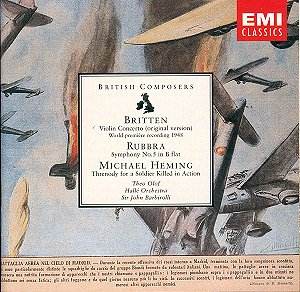Listening to Theo Olof's flourishingly passionate attack
and imaginative deftness in the Britten concerto I was reminded
of Olof's similar and equally fruitful pioneering of the Rawsthorne
first violin concerto. Ida Haendel breathed just as much romantic plasma
into this work when she tackled it with Berglund in the 1970s. The vibrancy
of Olof's approach is quite at odds with the colder objectivity of the
Decca recording artists from the Britten ‘true way’ - Mark Lubotsky,
the composer and the ECO. Rodney Friend in his CFP recording was almost
as fiery. The engineering of the Olof is not of the best. The sound
is stable if whiskery.
The Heming Threnody was woven from various
sketches left behind by Michael Heming, son of the baritone Percy Heming.
Michael was killed in action at El Alamein the first true Allied victory
of the Second World War. Anthony Collins (he of Beulah Sibelius fame)
created this work and it has some passing echoes of Butterwoth's Shropshire
Lad Rhapsody and the delicacy of Delius and of Schreker and Zemlinsky.
It is not a work of great dramaturgical landmarks and its thematic material
is not indelible stuff.
The Rubbra symphony was recorded in the composer's
presence. It was the first of the composer's symphonies to be recorded
under a project funded by the British Council. Boult rather than Barbirolli
had given the premiere but Barbirolli was the one who ran with the work
including it in the Hallé's 1949-50 season and at Cheltenham
where he and his orchestra were a perennial fixture until the anti-romantic
tendency began to tighten its death grip. For upwards of two decades
this was the only Rubbra symphony in the catalogue. This situation was
only changed by Boult's Lyrita SRCS recording of the Seventh symphony
in 1970. The Fifth is commonly reckoned to be his most popular but although
it has some considerable virtues (including some of Rubbra's best thematic
invention) it stands eclipsed by the truly symphonic gravity that radiates
from the Fourth and Eleventh Symphonies. How different Rubbra's story
might have been if the Fourth rather than the Fifth had been recorded.
There is a seriousness and a smallness of scale about the Fifth. However
when the gravity of affairs subsides as in the allegro vivo and
the allegro moderato the music dances like brusque and blustering
angels. The recording quality is good with solo lines emerging with
strength.
Extremely valuable notes by Michael Kennedy reminding
us, amongst much else, that BBC house conductor Maurice Handford was
in the horn section of the Hallé for the recording of the Rubbra
symphony.
Vintage recordings of rare material.
Rob Barnett
